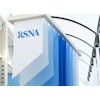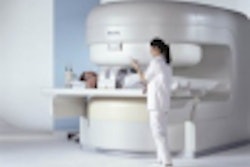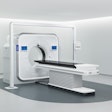Philips Medical Systems
Booth #7150
Philips Medical Systems will be showcasing the latest improvements to its HDI 5000 system, and will be launching the EnVisor scanner in the U.S.
HDI 5000 has undergone a makeover, with improved ergonomics featuring a fully articulating monitor and an integrated footrest and palmrest for the sonographer. These design changes contribute to improved comfort while scanning through better posture, less repetitive motion, and decreased neck and back strain, according to the Andover, MA-based vendor.
The product features a re-engineered computing architecture with increased processing power. The system also includes the company’s XRES technology, adapted from Philips MR algorithms, which reduces image artifacts, refines tissue textures, and sharpens structural detail, according to the company. In addition, the software incorporates Philips’ SonoCT imaging technology, combining up to nine lines of sight to provide real-time spatial compound imaging.
HDI 5000 also has a one-button feature, iSCAN Intelligent Optimization, that combines several control-panel functions needed to optimize 2-D image quality and Doppler spectral waveforms, decreasing image-quality variability.
The EnVisor system, originally demonstrated at the Journées Françaises de Radiologie conference in Paris this October, is targeted at the mid-range segment. The system consists of two models, EnVisor and EnVisor HD, and is configurable for general radiology or shared-service settings to meet price, performance, and clinical application requirements. A dedicated cardiology model, Envisor C, is also available.
The product features trapezoidal, color-flow, adaptive Doppler, color Doppler, color power angiography, directional color power angiography, tissue Doppler imaging, M-mode, pulsed Doppler, dual-image, triplex, 2-D, and 3-D imaging, as well as an advanced stress-echo option. An intelligent Doppler function automatically adjusts to a specified scanning angle as the user adjusts for flow direction. The system has a fully articulating keyboard and monitor, as well as a control panel that moves up and down.
Additionally, the product has integrated image- and data-management capabilities for reviewing, storing, and sharing patient study information. Images and reports can be archived via a DICOM compatible network or through various removable media, including CD-RW.
Siemens Medical Systems -- Ultrasound Division
Booth #1129
Siemens Ultrasound will be highlighting its Sonoline G50 and G60 S ultrasound imaging systems, which began shipping this November and July, respectively. In addition, the Malvern, PA-based vendor will demonstrate release 2.0 upgrades for its Sonoline Antares product, and a Signature II option for its Acuson Sequoia system.
The Sonoline G60 S system includes technology such as MultiBeam Formation, Precision MotionCapture, and SynAps (synthetic aperture), and can accommodate a full range of imaging applications, including cardiac imaging, according to the vendor. For cardiology, the product includes an integrated stress-echo package and multiplane transesophageal echo capability.
The scanner’s core architecture is based on the company’s DIMAQ-IP integrated workstation, which provides on-board image and data management. It also includes programmable imaging parameters, exam steps, measurement and report packages, and embedded DICOM compatibility, Siemens said. The company has also migrated its SieScape panoramic imaging, tissue-harmonic imaging, and integrated stress-echo packages to Sonoline G60 S.
Sonoline G50 is an all-digital ultrasound system suitable for ob/gyn, abdominal, vascular, shared-service cardiac, and urology applications in a private-office setting. The G50 model includes tissue harmonic imaging, AutoColor technology, multiple-frequency imaging, and directional power-Doppler imaging. The product can also be configured with options such as digital archiving, review and transfer of complete ultrasound studies, SieScape panoramic imaging, and cardiac imaging, Siemens said.
The release 2.0 upgrade package to the Sonoline Antares includes options such as tissue equalization technology migrated from the Acuson Sequoia system, SieScape panoramic imaging, multiview spatial compounding, real-time 3-D imaging and Cadence contrast agent imaging. This bundle also provides some standard feature upgrades, including additional imaging capabilities for selected transducers; workflow enhancements; and newly updated measurement, reporting, annotation, and pictogram packages for such applications as neonatal head, pediatric abdomen, fetal echo, and prostate imaging.
The flagship Acuson Sequoia system has been given a facelift with an available Signature II option. The option includes an advanced imaging package that utilizes CHIRP coded excitation, dynamic transmit focus, coherent phase inversion, real-time spatial compounding, transmit compounding, and background noise suppression.
The Signature II option also features Cadence contrast pulse sequencing, which detects the nonlinear fundamental and higher-order harmonic signals from contrast agents. Also available with Signature II is FreeStyle Dynamic CDI, which provides the capability to display dynamic real-time color Doppler information over the extended field-of-view image, and 3-D multiplanar reformatting with color, which provides the capability to view anatomical planes not achievable with normal scanning techniques, according to the firm.
SonoSite
Booth #6710
Handheld-ultrasound developer SonoSite of Bothell, WA, will be featuring two personal imaging tools to supplement its 180Plus and SonoHeart Elite systems at this year’s conference. The products, iLook 15 and iLook 25, each weigh 3 lbs and can be handheld during use, with a single application-specific transducer affixed.
iLook 15 has a 15-mm 4-2 MHz curved-array transducer for quick views of the heart or abdomen. iLook 25 has a 25-mm 10-5 MHz linear-array probe for procedure guidance, such as line placements. Both products can be battery or line operated and feature a 5.5-inch LCD monitor, color power Doppler, and storage for up to 60 images.
The iLook 25 unit is being targeted by the company for use in interventional work to guide such procedures as line placements, biopsies, and drainages. Price points for the scanner range from $14,000 to $15,000, depending on configuration.
iLook 15 is being targeted at applications that require a quick view by the clinician, such as basic cardiac function, fluid location, and drainage-procedure guidance. Pricing for the system ranges from $12,000 to $13,000, depending on configuration.
Terason
Booth #1841
Handheld-ultrasound developer Terason of Burlington, MA, will be revealing an enhanced and more robust Terason Ultrasound System at the RSNA conference. The system is based on an open, Microsoft Windows-powered PC platform. The new release offers color- and pulsed-wave Doppler, self-installing software, integration with other applications, such as 3-D reconstruction and calculation packages, and multiple hardware configuration options.
It features 128 beamforming channels and high-end transducers; in addition, the scanner’s "system on a chip" replaces conventional electronics and reduces the weight of the product to 10 ounces, according to the company. The product is targeted at interventional, ob/gyn, vascular, breast, phlebology, and mobile applications. The Terason Ultrasound System is currently available in the U.S. and the rest of the world and has a list price of $26,000.
Toshiba America Medical Systems
Booth #7729
Multimodality manufacturer Toshiba of Tustin, CA, will reprise its launch of Aplio, the new ultrasound platform first seen at last year’s meeting. The high-end system is DICOM-compliant and is targeted at the obstetrics/gynecology, vascular, breast, interventional, renal, genitourinary, and general imaging markets.
It features the vendor’s Dynamic Flow Plus and Pulse subtraction Plus applications; multi-frequency and dynamic microslice transducer technology, multiplanar, surface rendering and fusion 3-D capabilities; and Toshiba’s I touch user interface. The product is currently available at an average price of $165,000 to $225,000 depending on the configuration.
The Nemio 10, 20, and 30 series of ultrasound systems will also be on display for conference attendees. The model line is targeted at a wide range of applications such as obstetrics/gynecology, vascular, breast, interventional, renal, genitourinary, intraoperative, laparoscopic, invasive and non-invasive cardiology, and general imaging. Average pricing on the units is between $28,000 to $130,000, depending on the model and configuration.
Go to page:
Biosound to Medison
Philips to Toshiba
By Jonathan S. Batchelor
AuntMinnie.com staff writer
November 18, 2002
Copyright © 2002 AuntMinnie.com



















